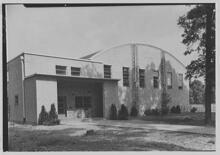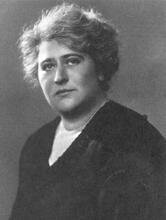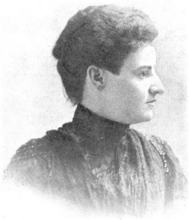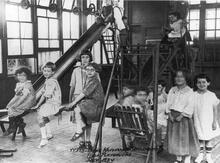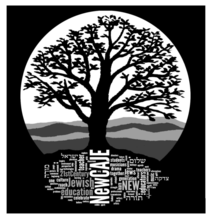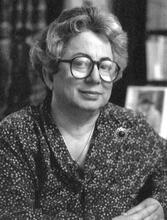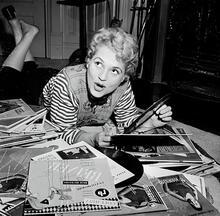Selina Greenbaum
Seeing a need for young women to experience some freedom from the oppressive conditions of factory work, Selina Greenbaum created country resorts where women could take a much-needed vacation. Greenbaum studied at Hunter College before marrying Samuel Greenbaum, who would later become a New York State Supreme Court justice, in 1888. She began involving herself in Jewish organizations as a board member of the National Council of Jewish Women and president of the downtown auxiliary of the YWHA. After an urgent plea from the Board of Jewish Ministers in 1898 for educational and recreational activities to enrich the lives of factory workers, Greenbaum became the founding president of the Jewish Working Girl’s Vacation Society in 1890. The society created a number of vacation homes on Long Island and in the Adirondacks, where Jewish women of working age could pay a nominal fee for a two-week vacation. By 1917, the society had hosted over 800 women per year and also began providing midweek vacations for young mothers. The society moved its work to Connecticut in 1956 as Camp Isabella Freedman, where it continues its work as a Jewish retreat center.
Article
The life of the turn-of-the-century working girls of New York City’s Lower East Side was often one of austerity and exhausting drudgery. Alarmed by the horrific conditions of the tenement houses and sweatshops, the Board of Jewish Ministers issued an urgent call in 1898 for the provision of healthful recreational facilities for Jewish working girls. Selina Greenbaum was among those influential East Side women who responded to the call, devoting time and energy to the organization of much-needed educational and recreational activities for women.
Selina (Ullman) Greenbaum was born on April 6, 1866, in New York City, the sixth of seven children and third of four daughters of Israel and Julia (Blumenthal) Ullman, emigrés from Bavaria who had made their home on Manhattan’s Upper East Side. Israel Ullman’s dry-goods dealership provided a comfortable living for the family, and Selina was educated in the New York public schools and at Normal College (now Hunter College). On March 13, 1888, she married Samuel Greenbaum, who was supreme court justice for New York from 1900 until 1929.
Like her husband, whose prominent communal leadership included the presidency of the Educational Alliance, Greenbaum was notable for Jewish charity work. One of the early members of the board of directors of the National Council of Jewish Women, she also became involved with the nascent Young Women’s Hebrew Association (YWHA), organized in 1888 under the leadership of Julia Richman as an auxiliary to the YMHA. Greenbaum was a president of this first downtown auxiliary, as well as an active member of the board of directors of the first recreation rooms on the Lower East Side, which opened in May 1898.
It was in 1890, however, that Greenbaum made her most important contribution to public service. She was instrumental in forming the Jewish Working Girls’ Vacation Society and took office as its first president, a position she held for many years. Incorporated in 1892, the society maintained homes in Bellport and Arverne on Long Island and at Big Indian and Margaretville in the Adirondacks (New York), where, for a nominal fee, Jewish girls of working age enjoyed a fortnight of vacation from the city. By 1917, the society was assisting over eight hundred girls annually and was also able to provide midweek holidays for mothers.
The Greenbaums raised a family of four children at their home on East 94th Street in Manhattan. Their two sons, Lawrence and Edward, pursued successful careers as attorneys, while both daughters were active in community service. Grace Greenbaum Epstein founded a women’s job bureau during the Depression, while Isabel Greenbaum Stone established the Windward School in Harrison, New York.
Selina Greenbaum died at the Greenbaum summer home in Larchmont, New York, on July 15, 1925. The activities of the Jewish Working Girls’ Vacation Society continue today under the auspices of Camp Isabella Friedman, the direct descendant of Greenbaum’s original project.
AJYB 1, s.v. “Jewish Working Girls’ Vacation Society,” and 7 (1905–1906): 64.
Bellport-Brookhaven Historical Society, New York. Collection of photographic postcards of the Bay House, Bellport, Long Island.
Kehillah (Jewish Community) of New York City. The Jewish Communal Register of New York City, 1917–1918, s.v. “Jewish Working Girls’ Vacation Society,” and “Recreation Rooms and Settlements”.
Lubitz, Bertha. “Preventive Work for Girls.” Jewish Charity 3 (1904): 217–220.
Obituary. NYTimes, July 16, 1925, 19:6.
Rabinowitz, Benjamin. The Young Men’s Hebrew Associations and the Jewish Community Center Movement (1937?).
Straus, Mrs. Isidor. “The Recreation Room for Girls.” Jewish Charity 4 (1905): 117–119.
Straus, Sara. “Working Girls’ Clubs.” Jewish Charity 3 (1904): 153–161.
Wald, Lillian D., et al. “Summer Outings for the Jewish Poor.” Jewish Charity 3 (1904): 190–192.
Young Men’s Hebrew Association of New York. Scrapbook papers. Ninety-second Street YMCA, NYC.


